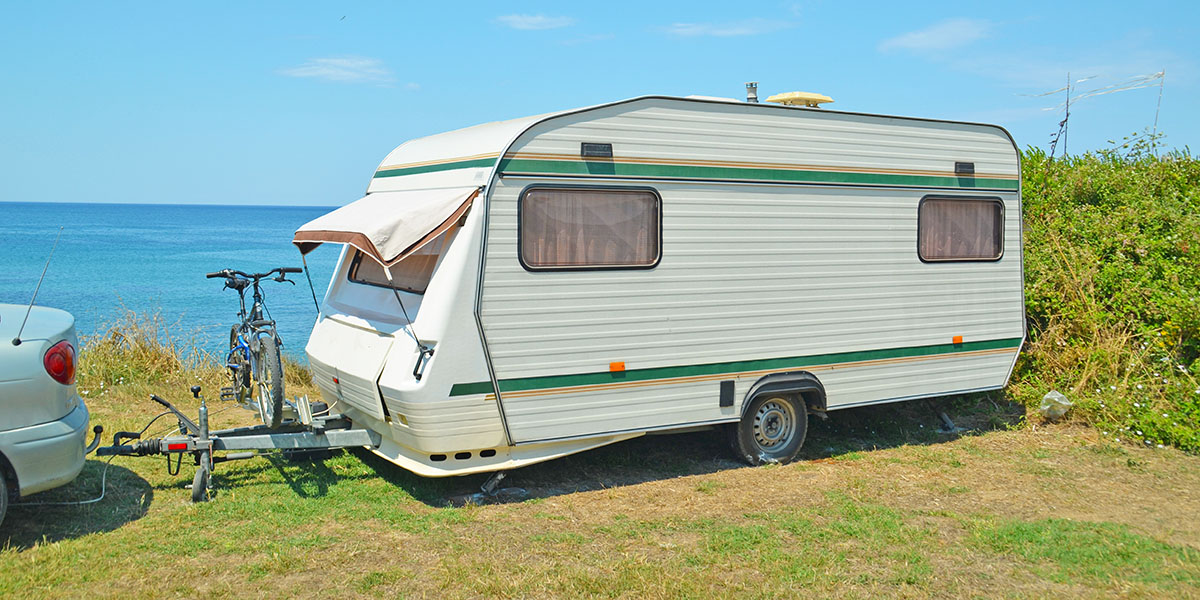It’s time. Finally. Your whole calendar year has been building up to this moment. It’s time to crack open that garage or storage unit. Or to take a stroll to the back forty where you last left your great love for the winter. It’s time to rekindle the flames of adventure. To stoke the embers of romance with the great outdoors beyond the horizon. That’s right: IT’S RV SEASON AGAIN! But, before you get too carried away (who could blame you?), remember: Dewinterizing an RV is essential.
Like any great relationship, it would be foolish to just hop into the saddle and take off. This old love of yours needs a little work to get humming back into harmony. Because if you were smart (and you’re an RV Trader reader, so we’ll assume yes), you made some careful winterizing tweaks to your adventure-on-wheels before putting her to bed.
So, let’s take a look at what you need to do and undo when dewinterizing an RV.
Basic Tasks for Dewinterizing an RV
Here’s a checklist of the most elementary dos and undos:
Flush the pipes.
Depending on how far into the wintery north you last parked, you might’ve added some nontoxic RV antifreeze to your water system. One of your most important dewinterizing steps is giving that a healthy flush. Turn on your water pump, and let all your faucets vent until the water runs clear. If you’ve got a water heater, turn it on and check that it’s functional. And if you find any residual taste or odor from the anti-freeze liquid, try running some baking soda through the system.
Because your water system sat stagnant for months, it’s always possible that bacteria may have built up, so you’ll also want to sanitize the system. Here’s our look at water system maintenance, with tips for filling and cleaning.
Give your tires a good pump.
Count on dropping around two to three PSI per month as a general rule, so get out the pump and go to town. Check your owner’s manual for the correct fill pressure.
Reinstall and charge your batteries.
Just like tires, your electrical system is likely to lose a little bit of oomph while sitting dormant. So, make sure you’re fully charged. Charge and inspect your backup system too. If you don’t have one, now’s a great time to make sure you’re never stuck without power by picking up an RV-friendly battery charger.
Update your license and registration, please.
If it’s been months since you hit the road, it’s a good time to double-check that your registration is up-to-date.
Change your filters.
Now’s also the perfect time to get up-to-date on your air and water filter changeouts.
Get your motor running!
Check all your fluid levels, then start that engine! Extreme temperatures can be hard on engines, so let it run for a few minutes. Then look for any drips, sneaky drops, or seeping fluids.
Check Off Your Annual Checklist
Whether you have a Class A motorcoach or a pull-behind travel trailer that oozes your personality, there are plenty of preventative maintenance checks you should be doing annually. Just like my grandma used to check all of her smoke detectors when spring cleaning, now’s a great time to knock some of those annual tasks out. Here are a few you should consider when dewinterizing an RV.
Perform a water leak check.
While you’re sanitizing your water system, turn on your water pump and listen for it to shut off. That means your system is fully pressurized. Listen for the next several minutes to ensure the pump doesn’t kick back on. While listening, check your toilet, shower, and sink for any dripping or seeping water. If your pump does turn back on, you’ve got some leak hunting to do, as you’re losing pressure from somewhere. If your system is leak-free, the pump will stay off. So, if you hear nothing, you’re likely good to go.
Check your propane system.
Open the gas lines and sniff around for any strange smells. Then, fire up each of your appliances to ensure they’re still working properly.
Perform a tire check.
You’ll already be getting pumped up, so check your tires while you’re at it for any signs of wear. Tire issues while on the road can be a HUGE problem, and many problems can be avoided with proper attention and care.
Visually inspect your RV, camper, or trailer’s exterior.
Changes in temperature can be hard on all sorts of materials, especially plastic and rubber. Check weatherstripping around windows, air vents, and doors. Look for any developing rust on metal surfaces. And check for cracks in plastics or other facades.
Test your generator.
Check your oil level and make sure your exhaust is clear. Then let ‘er rip, testing for proper performance on each electrical system and appliance. Remember that power is a critical safety feature, and don’t accept anything less than peak, reliable performance.
Restock safety and emergency supplies.
Check dates on any expirable materials, including medication. Restock any items you may have used, like Band-Aids, bug spray, or other consumables. Do a double check also of all safety items in case of emergency.
Regular maintenance is critical to making the most out of your RV, so hopefully you’re putting the work in all year long! Here’s a look at some items you should have on-hand to make regular maintenance a snap.

Leave a Reply